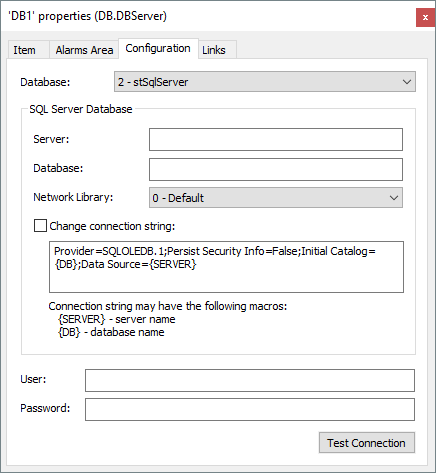To insert a new SQL Server Database, follow these procedures:
1.Right-click the project's name in Explorer and select the Insert - Database option. In Domain mode, right-click the Server objects - Databases item, select the Insert Database In option, and then the project's name. The object is then created and its script edition window is opened.
2.To configure it, select the Configuration tab on the Properties Window.

Configuration for SQL Server Databases
The available options on this tab are described on the next table.
Available options for Configuration tab
Option |
Description |
|---|---|
Database |
Selects a project's Database type. Possible values for this option are 0: stAccess, 1: stOracle, or 2: stSqlServer |
Server |
Server name |
Database |
Database name |
Network Library |
Network library used by ADO. Possible values for this option are 0: Default, 1: Named Pipes, 2: Winsock TCP/IP, 3: SPX/IPX, 4: Banyan Vines, or 5: Multi-Protocol (RCP) |
Change connection string |
This check box allows changing the String to connect to a SQL Server database. The following restrictions apply to this option: •Performed changes ARE NOT validated by E3. Therefore, users are fully responsible for configuring this customized String correctly •If this check box is not selected, E3 uses a default format to perform this connection •This connection String accepts macros {SERVER}, which is replaced by server's name configured in the Server option, and {DB}, which is replaced by database's name configured in the Database option |
User |
Database user connected via E3. Depending on the type of object to use in the project, they must have different kinds of permissions |
Password |
Password of the user performing the logon |
Test Connection |
Tests the connection with the Database |
3.In the Database field, select the 2 - stSqlServer option.
4.If necessary, configure the User and Password options according to SQL Server's definitions. These items may remain blank and, in this case, an application assumes E3's default settings.
5.Click OK to finish these settings.